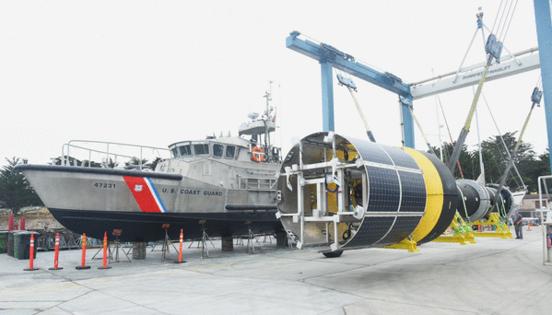Naval Postgraduate School launches sustainable buoy to advance research
Published in Science & Technology News
MONTEREY, Calif. — Located about 3 miles offshore and 5 miles north of the Naval Postgraduate School is a first-of-its-kind ocean-sensing buoy. With 5G technologies and solar panels built in, the buoy has the capabilities to collect oceanographic and meteorological data 24 hours a day, seven days a week for the next three years.
NPS worked to develop and now lease the PowerBuoy from Ocean Power Technologies, a New Jersey-based company specializing in clean ocean-energy technology, and AT&T. With the help of AT&T’s 5G technologies, the buoy will also serve to enhance communications at sea for the Navy and other mariners that come in contact with it. The buoy will remain in the ocean for three years, brought to the surface occasionally for upkeep.
“NPS has a long history of doing applied field experimentation … we have naval officers, permanent defense service officers and international students and they’re all coming here for graduate education, all of it being somehow related to the problems they’re facing within the Defense Department,” said Kevin Smith, principal investigator and chair of the physics department at the school.
“It’s really nice as both a graduate education institution and a Navy organization that we get to see the combination of the fundamental science and understanding of how things work, with seeing how that could apply and improve the effectiveness of our Department of Defense,” he said.
The school worked with the National Oceanic and Atmospheric Administration, the California State Lands and Coastal Commissions and other organizations to ensure the buoy was properly permitted and wouldn’t cause a negative environmental impact.
Powered by solar and wind energy, the buoy will collect undersea and surface data and relay that information to researchers at NPS through its 5G communication technology. The 5G maritime base station can also provide internet access, high-speed data transmission and communication capabilities to vessels within a half-mile radius. Part of the research looking forward will be to determine how far 5G can be extended in the maritime domain, according to Smith.
“We are excited to complete this installation and move into the lease phase of our contract with NPS,” said Philipp Stratmann, CEO of Ocean Power Technologies in a news release. “The collaboration with AT&T also demonstrates how PowerBuoys can serve as 5G communications nodes along the U.S. coastline.”
The buoy will help bring high-speed data to mariners who have been limited by VHF radio and satellite communication, which is more expensive than the 5G.
“At AT&T, we modernize network infrastructure to support the technologies of the future,” said Wes Anderson, public sector president in a news release. “That’s why we’re proud to have launched a 5G cell site at sea with the Navy, Naval Postgraduate School and OPT. This collaboration fuels our commitment to developing 5G and edge computing solutions for manned and unmanned naval platforms that support national defense, homeland security and the maritime community.”
Bringing Ocean Power Technologies and AT&T together to create this buoy “was sort of a natural fit,” said Smith.
While NPS is the project lead, multiple institutions are involved with the buoy and will rely on it for data. Some of the partnerships include NOAA, the Stanford Doerr School of Sustainability, Monterey Bay Aquarium Research Institute and the U.S. Coast Guard.
The buoy has several practical applications that researchers are looking to utilize. From a Navy perspective, the buoy can track submarines and weather patterns to make predictions on the impact of the environment on operational systems, said Smith.
But there are also opportunities to track what’s happening underwater, including marine mammal activity – that data will be provided to the Monterey Bay Aquarium Research Institute. Information on sea surface temperature and wave energy, for example, can go to NOAA as well as fishermen.
“There’s a lot of dual use to all these studies that we’re doing and that’s, again, one of the great things about being an educational institution and a Navy organization is that we’re able to see both applications and study them accordingly,” said Smith.
Looking forward, the hope is that the buoy will transform the possibilities of what a maritime base station can look like.
“I don’t expect that we will put multiple buoys out in Monterey Bay,” said Smith. “This is sort of a testbed.”
The capabilities of the buoy and the sensors that have been built into it will hopefully promote the concept to other organizations, said Smith, and help support more of these stations popping up throughout the world to advance what we know about the ocean. Multiple buoys in Monterey aren’t the goal, but rather a chance to highlight how other areas could expand on the idea.
“That is a vision,” said Smith. “Not for Monterey Bay, but for other locations around the world.”
_____
©2025 MediaNews Group, Inc. Visit at montereyherald.com. Distributed by Tribune Content Agency, LLC.







Comments